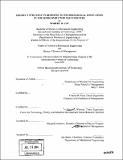| dc.contributor.advisor | Charles H. Fine and Daniel E. Whitney. | en_US |
| dc.contributor.author | Lin, Robert W. (Robert Wei-Pang), 1976- | en_US |
| dc.contributor.other | Leaders for Manufacturing Program. | en_US |
| dc.date.accessioned | 2006-11-08T16:39:11Z | |
| dc.date.available | 2006-11-08T16:39:11Z | |
| dc.date.copyright | 2004 | en_US |
| dc.date.issued | 2004 | en_US |
| dc.identifier.uri | http://hdl.handle.net/1721.1/34793 | |
| dc.description | Thesis (S.M.)--Massachusetts Institute of Technology, Dept. of Mechanical Engineering; and, (S.M.)--Massachusetts Institute of Technology, Sloan School of Management; in conjunction with the Leaders for Manufacturing Program at MIT, 2004. | en_US |
| dc.description | Includes bibliographical references (p. 82-84). | en_US |
| dc.description.abstract | After the market boom of 2000 in the semiconductor industry changed significantly. The changes included stricter limits on capital cost spending, and the increased propensity of the industry to outsource the manufacturing of semiconductors. Thus, the semiconductor industry demanded greater cost of test economics in semiconductor test equipment. In response to the changes in the industry and the customer demands, the semiconductor test industry segmented itself into two broad strategies. Typically, the large semiconductor test equipment manufacturers employed a broad platform strategy, while the smaller semiconductor test equipment manufacturers employed a niche platform strategy. This thesis confirms the underlying changes in the semiconductor test industry by looking at the entire semiconductor value chain. It also looks at the root causes of the changes in order to determine the future effects of the changes in the semiconductor test industry. This thesis also analyzes the two distinct market strategies, developing a systematic method to compare and evaluate each strategy. In addition, it explores the intangible risks associated with the adoption of each strategy. After understanding the trends in the semiconductor test industry, this thesis also presents a unified model to discuss the future direction of the semiconductor test industry. Looking at this direction, this project develops specific recommendations for businesses to compete effectively given the impending market conditions. | en_US |
| dc.description.statementofresponsibility | by Robert W. Lin. | en_US |
| dc.format.extent | 84 p. | en_US |
| dc.format.extent | 5197216 bytes | |
| dc.format.extent | 5197024 bytes | |
| dc.format.mimetype | application/pdf | |
| dc.format.mimetype | application/pdf | |
| dc.language.iso | eng | en_US |
| dc.publisher | Massachusetts Institute of Technology | en_US |
| dc.rights | M.I.T. theses are protected by copyright. They may be viewed from this source for any purpose, but reproduction or distribution in any format is prohibited without written permission. See provided URL for inquiries about permission. | en_US |
| dc.rights.uri | http://dspace.mit.edu/handle/1721.1/7582 | |
| dc.subject | Mechanical Engineering. | en_US |
| dc.subject | Sloan School of Management. | en_US |
| dc.subject | Leaders for Manufacturing Program. | en_US |
| dc.title | Product strategy in response to technological innovation in the semiconductor test industry | en_US |
| dc.type | Thesis | en_US |
| dc.description.degree | S.M. | en_US |
| dc.contributor.department | Leaders for Manufacturing Program at MIT | en_US |
| dc.contributor.department | Massachusetts Institute of Technology. Department of Mechanical Engineering | |
| dc.contributor.department | Sloan School of Management | |
| dc.identifier.oclc | 56890738 | en_US |
